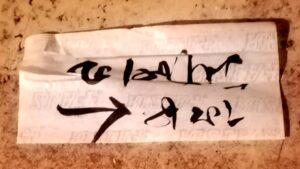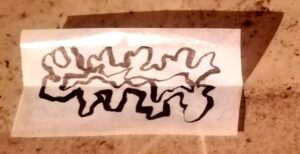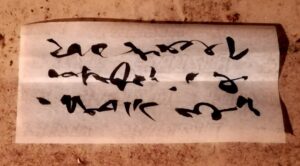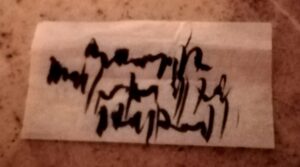installances nn. : # 0130, 0131, 0132, 0133, 0134, 0135, 0136 type : asemic glyphs on rizla paper size : cm 7 x 3.5 record : highres shot additional notes : abandoned/hidden date : Dec. 7th, 2019 time : approx h. 5:30pm place : Rome, Studio Campo Boario note: on the occasion of the art exhibit "Monster Me", 6-7 Dec., 2019
Archivi categoria: abandoned
i.0087, untitled (red written fragment)
i.0086, untitled (tiny string of wool)
i.0085, untitled ($)
on the moon (1971)
This tiny sculpture is called Fallen Astronaut, and was placed on the lunar surface by the crew of Apollo 15 on August 1, 1971.
The figurine, which was crafted in the likeness of an astronaut-in-spacesuit, measures just more than three inches tall, but the “Smallest Memorial in the Universe,” as Walter Cronkite called it in a 1972 interview with its creator, Belgian sculptor Paul van Hoeydonck, gave rise to storm of controversy disproportionate to its physical size. Over at Slate, Corey S. Powell and Laurie Gwen Shapiro have the in-depth story of the scandals and conflicts that “obscured one of the most extraordinary achievements of the Space Age.”
It begins:
One crisp March morning in 1969, artist Paul van Hoeydonck was visiting his Manhattan gallery when he stumbled into the middle of a startling conversation. Louise Tolliver Deutschman, the gallery’s director, was making an energetic pitch to Dick Waddell, the owner. “Why don’t we put a sculpture of Paul’s on the moon,” she insisted. Before Waddell could reply, van Hoeydonck inserted himself into the exchange: “Are you completely nuts? How would we even do it?”Deutschman stood her ground. “I don’t know,” she replied, “but I’ll figure out a way.”She did.At 12:18 a.m. Greenwich Mean Time on Aug. 2, 1971, Commander David Scott of Apollo 15 placed a 3 1/2-inch-tall aluminum sculpture onto the dusty surface of a small crater near his parked lunar rover. At that moment the moon transformed from an airless ball of rock into the largest exhibition space in the known universe. Scott regarded the moment as tribute to the heroic astronauts and cosmonauts who had given their lives in the space race. Van Hoeydonck was thrilled that his art was pointing the way to a human destiny beyond Earth and expected that he would soon be “bigger than Picasso.”In reality, van Hoeydonck’s lunar sculpture, called Fallen Astronaut, inspired not celebration but scandal. Within three years, Waddell’s gallery had gone bankrupt. Scott was hounded by a congressional investigation and left NASA on shaky terms. Van Hoeydonck, accused of profiteering from the public space program, retreated to a modest career in his native Belgium. Now both in their 80s, Scott and van Hoeydonck still see themselves unfairly maligned in blogs and Wikipedia pages—to the extent that Fallen Astronaut is remembered at all.And yet, the spirit of Fallen Astronaut is more relevant today than ever. Google is promoting a $30 million prize for private adventurers to send robots to the moon in the next few years; companies such as SpaceX and Virgin Galactic are creating a new for-profit infrastructure of human spaceflight; and David Scott is grooming Brown University undergrads to become the next generation of cosmic adventurers.Governments come and go, public sentiment waxes and wanes, but the dream of reaching to the stars lives on. Fallen Astronaut does, too, hanging eternally 238,000 miles above our heads. Here, for the first time, we tell the full, tangled tale behind one of the smallest yet most extraordinary achievements of the Space Age.
i.0083, untitled (rizlasemics)
i.0082, untitled (asemic fragment)
i.0081, untitled (rizlasemic)
alla dispersione / emilio villa
Guarda che siamo di Eleusi. […] Qui il più severo e il più vero inventore sono io, che ho inventato la poesia distrutta, data in pasto sacrificale alla Dispersione, all’Annichilimento: sono il solo che ha buttato il meglio che ha fatto: quello che s’è consumato nella tasca di dietro dei calzoni scappando di qua e di là, quello scritto sui sassi buttati a Tevere, quello stampato da un tipografo che non c’è più, quello lasciato in una camera di via della croce. Solo così si poteva andare oltre la pagina bianca: con la pagina annientata.
Emilio Villa, da un appunto (“risalente alla fine degli anni Settanta o all’inizio degli Ottanta”, cfr. A.Tagliaferri, Il clandestino. Vita e opere di Emilio Villa, DeriveApprodi, Roma 2004, p. 183)
















